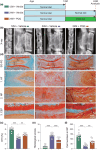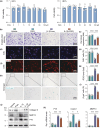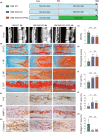Nrf2 activation by pyrroloquinoline quinone inhibits natural aging-related intervertebral disk degeneration in mice
- PMID: 38780001
- PMCID: PMC11320358
- DOI: 10.1111/acel.14202
Nrf2 activation by pyrroloquinoline quinone inhibits natural aging-related intervertebral disk degeneration in mice
Abstract
Age-related intervertebral disk degeneration (IVDD) involves increased oxidative damage, cellular senescence, and matrix degradation. Pyrroloquinoline quinone (PQQ) is a water-soluble vitamin-like compound with strong anti-oxidant capacity. The goal of this study was to determine whether PQQ can prevent aging-related IVDD, and the underlying mechanism. Here, we found that dietary PQQ supplementation for 12 months alleviated IVDD phenotypes in aged mice, including increased disk height index and reduced histological scores and cell loss, without toxicity. Mechanistically, PQQ inhibited oxidative stress, cellular senescence, and senescence-associated secretory phenotype (SASP) in the nucleus pulposus and annulus fibrosus of aged mice. Similarly, PQQ protected against interleukin-1β-induced matrix degradation, reactive oxygen species accumulation, and senescence in human nucleus pulposus cells (NPCs) in vitro. Molecular docking predicted and biochemical assays validated that PQQ interacts with specific residues to dissociate the Keap1-Nrf2 complex, thereby increasing nuclear Nrf2 translocation and activation of Nrf2-ARE signaling. RNA sequencing and luciferase assays revealed Nrf2 can transcriptionally upregulate Wnt5a by binding to its promoter, while Wnt5a knockdown prevented PQQ inhibition of matrix metalloproteinase-13 in NPCs. Notably, PQQ supplementation failed to alleviate aging-associated IVDD phenotypes and oxidative stress in aged Nrf2 knockout mice, indicating Nrf2 is indispensable for PQQ bioactivities. Collectively, this study demonstrates Nrf2 activation by PQQ inhibits aging-induced IVDD by attenuating cellular senescence and matrix degradation. This study clarifies Keap1-Nrf2-Wnt5a axis as the novel signaling underlying the protective effects of PQQ against aging-related IVDD, and provides evidence for PQQ as a potential agent for clinical prevention and treatment of natural aging-induced IVDD.
Keywords: IVDD; Keap1–Nrf2 signaling; Wnt5a; aging; pyrroloquinoline quinone.
© 2024 The Authors. Aging Cell published by Anatomical Society and John Wiley & Sons Ltd.
Conflict of interest statement
None declared.
Figures






References
-
- Chen, J. , Zhang, J. , Li, J. , Qin, R. , Lu, N. , Goltzman, D. , Miao, D. , & Yang, R. (2023). 1,25‐dihydroxyvitamin D deficiency accelerates aging‐related osteoarthritis via downregulation of Sirt1 in mice. International Journal of Biological Sciences, 19(2), 610–624. 10.7150/ijbs.78785 - DOI - PMC - PubMed
-
- Chowanadisai, W. , Bauerly, K. A. , Tchaparian, E. , Wong, A. , Cortopassi, G. A. , & Rucker, R. B. (2010). Pyrroloquinoline quinone stimulates mitochondrial biogenesis through cAMP response element‐binding protein phosphorylation and increased PGC‐1alpha expression. The Journal of Biological Chemistry, 285(1), 142–152. 10.1074/jbc.M109.030130 - DOI - PMC - PubMed
-
- Cullinan, S. B. , Gordan, J. D. , Jin, J. , Harper, J. W. , & Diehl, J. A. (2004). The Keap1‐BTB protein is an adaptor that bridges Nrf2 to a Cul3‐based E3 ligase: Oxidative stress sensing by a Cul3‐Keap1 ligase. Molecular and Cellular Biology, 24(19), 8477–8486. 10.1128/mcb.24.19.8477-8486.2004 - DOI - PMC - PubMed
MeSH terms
Substances
Grants and funding
LinkOut - more resources
Full Text Sources
Medical

